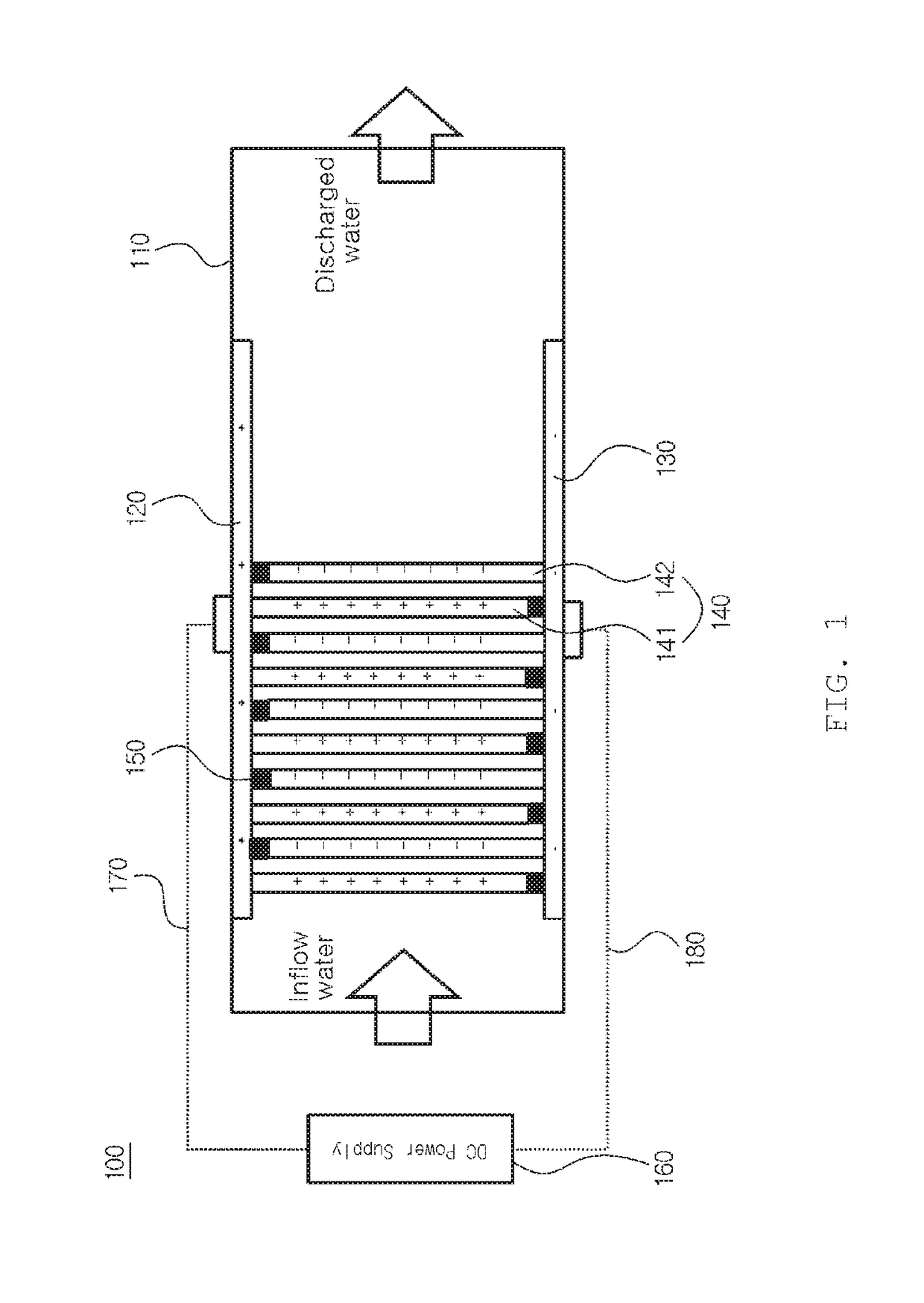3-dimensional porous mono-polar electrode body, electric sterilization filter including 3-dimensional porous mono-polar electrode body, and water treatment method using 3-dimensional porous mono-polar electrode body
a technology of porous mono-polar electrodes and electrode bodies, which is applied in the direction of transportation and packaging, vessel construction, and the nature of treatment water, can solve the problems of reducing current efficiency, significant loss of catalyst coat, and difficult tracking, so as to reduce the amount of catalyst coating, reduce current leakage, and reduce the lifetime of catalyst coats
- Summary
- Abstract
- Description
- Claims
- Application Information
AI Technical Summary
Benefits of technology
Problems solved by technology
Method used
Image
Examples
experimental example 1
[0092]In Experimental Example 1, the microorganisms were electrically removed using the 3-dimensional porous mono-polar electrode body 140.
[0093]A. Electric Sterilization Filter and Water Treatment System Using the Same (See FIGS. 1 and 6)
[0094](1) 3-Dimensional Porous Anode 141
[0095]Parent substance: Titanium fibers each having a porosity of 57.5%, an average pore diameter of 50±5 μm, a diameter of 10 cm, and a thickness of 0.5 mm
[0096]Catalyst layer: The parent substance was chemically washed with acid, dipped or brushed in a solution that included chlorides, including palladium, iridium, and ruthenium (weight ratio of 1:0.4:0.3), and alcohol, and sintered to form a catalyst layer.
[0097]Number: 1
[0098](2) 3-Dimensional Porous Cathode 142
[0099]Parent substance: Titanium fibers each having a porosity of 57.5%, an average pore diameter of 50±5 μm, a diameter of 10 cm, and a thickness of 0.5 mm were used as the parent substance without separate catalyst layer coating, and were subject...
experimental example 2
[0114]The applied current (voltage) was supplied in a pulse form under the same constitution and experimental conditions as Experimental Example 1 to compare microorganism removal abilities.
[0115]A. Electric sterilization filter and water treatment system using the same (see FIGS. 1 and 6)
[0116](1) 3-dimensional Porous Mono-Polar Electrode Body 140: the Same as Experimental Example 1
[0117](2) Power-Feeding Electrodes 120 and 130: the Same as Experimental Example 1
[0118](3) Operating Condition of the Water Treatment System (FIG. 6)
[0119]The operation condition was the same as Experimental Example 1, and the current application condition was changed.
[0120]Application of the current: A constant current of 0.1 A / cm2 was applied in a pulse form based on the area of the electrode (positive direction 30 min, and negative direction 30 min)
[0121]B. Analysis: the Same as Experimental Example 1
[0122]C. Result
[0123]The experimental result is described in Table 1. From Table 1, it was apparently...
experimental example 3
[0126]In Experimental Example 3, the microorganisms 50 μm or larger in size were electrically removed in order to check the possibility of applying the 3-dimensional porous mono-polar electrode body 140 of the present embodiment to the ballast water treatment process. The actual ballast water treatment process is shown in FIGS. 8 and 9. However, the ballast water treatment process was constituted to be the same as the process of FIG. 6 in order to check only the effect of electric sterilization filtering, which was performed to remove microorganisms 50 μm or larger in size, and then evaluated.
[0127]A. Electric Sterilization Filter and Water Treatment System Using the Same (see FIGS. 1 and 6)
[0128](1) 3-Dimensional Porous Mono-Polar Electrode Body 140: the Same as Experimental Example 1
[0129](2) Power-Feeding Electrodes 120 and 130: the Same as Experimental Example 1
[0130](3) Target microorganisms: Artemia salina (hereinafter, referred to as “A. salina”)
[0131]Artemia salina was purch...
PUM
| Property | Measurement | Unit |
|---|---|---|
| thickness | aaaaa | aaaaa |
| diameter | aaaaa | aaaaa |
| Dielectric breakdown | aaaaa | aaaaa |
Abstract
Description
Claims
Application Information
 Login to View More
Login to View More - R&D
- Intellectual Property
- Life Sciences
- Materials
- Tech Scout
- Unparalleled Data Quality
- Higher Quality Content
- 60% Fewer Hallucinations
Browse by: Latest US Patents, China's latest patents, Technical Efficacy Thesaurus, Application Domain, Technology Topic, Popular Technical Reports.
© 2025 PatSnap. All rights reserved.Legal|Privacy policy|Modern Slavery Act Transparency Statement|Sitemap|About US| Contact US: help@patsnap.com



